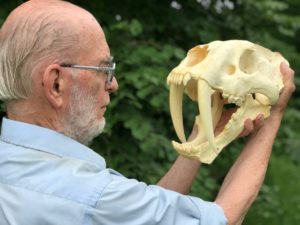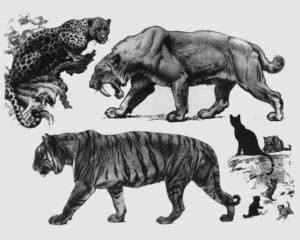Adventures in Deep Time: Cats and Horses
When I was a graduate student at UCLA in 1965, my summer job involved being a mineral collector and a fossil hunter for the Los Angeles County Museum of Natural History. One of my assignments was at Rancho La Brea, home of the famous tar pits, where fossils had already been mined for many decades. I was given a lot of freedom to search out new sites, or work the old ones. So I became a “pit person” for a while and learned to locate quality bone and extricate it without damage.

A museum-quality cast of “my” sabretooth cat
While it was exciting to find the skull of a dramatic 20-thousand-year-old extinct predator, removing it from its tomb of 20-million-year-old tar involved some long and grubby days. Much later, after we came to Iowa, I contacted the Museum and they arranged to make me a plastic cast of my favorite predator.
When you see the entire skeleton of one of these completely assembled, you realize that it was a massive beast. A large male mountain lion today can weigh up to 400 pounds. The sabretooth cat ran around 600 pounds, with formidable hardware, and sorta looked like a mountain lion on steroids.
You probably already know that on our federally owned western rangelands, the wild horse is considered an invasive species, using forage and water that native wildlife needs. You also know that the Plains Indians successfully domesticated horses, which were the descendants of Spanish horses brought over in the 1500s and 1600s, and these are also partly the ancestors of the wildlings of the west today.
But seen from the perspective of Deep Time, the horse/human story looks quite different. Horses, as a group of species, originally evolved here in North America some 40-50 million years ago, and the fossil record offers good detail. With the shifting of continents and the rise and fall of sea level, some of these later spread to Eurasia and Africa, becoming today’s zebra, the Arabian horse, the Spanish horse, etc. Horses persisted here in North America, alongside their sabretooth cat predator until about 13,000 years ago, and then both rather suddenly went extinct, along with most of the rest of the megafauna.

An artist’s concept of the sabretooth cat compared to a modern Asian tiger, a jaguar, and housecats, from Life Through the Ages by Charles Knight.
The timing of this extinction rather closely matches the arrival of humans. This same pattern prevails around much of the world, and when modern humans show up in the geologic record of Hawaii, New Zealand, Polynesia, South America, Wrangall Island, Australia, etc., many other species go extinct. This may just be circumstantial evidence, but no other plausible cause has been found.
So viewed over Deep Time, the horses were native to North America, and our species was the exotic late-arriving invasive that pushed them and their native predators into extinction.
Thus, there are folks who believe that the most desirable ecological restoration goal is to reference our animal species mix before any humans tampered with it. For midcontinent North America, there are still some living surrogates. For example, up until 13,000 years ago, we had a lion nearly indistinguishable from the African lion. We also had camel species, cheetah species, and horses. The mammoth was our version of the Asian elephant, and the wooly rhinoceros was closely equivalent to Asian rhinos. Today’s Asian tiger is built differently than the sabretooth cat, probably hunts differently, and perhaps is not a suitable surrogate.
Interesting to speculate about, stay tuned for the actual experiment at Pleistocene Park, in coming weeks.


